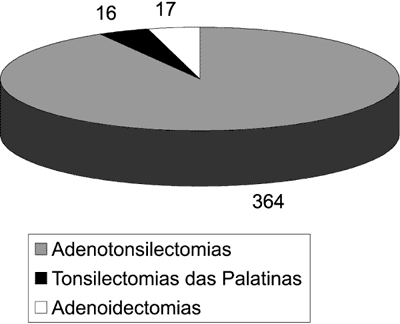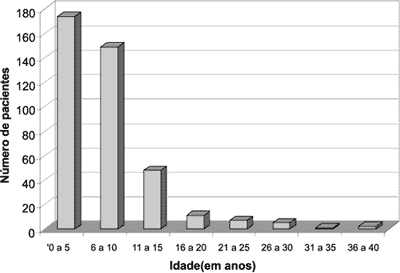

Year: 2004 Vol. 70 Ed. 6 - (7º)
Artigo Original
Pages: 762 to 772
Post-surgical hemorrhage in 397 adenoidectomy plus tonsillectomy operated at Pirajussara General Hospital and Diadema State Hospital / Federal University of Sao Paulo
Author(s): Gabriel Cesar Dib , Eduardo M. Kosugi1, Júlio M. Neto , Marcos L. Antunes , Douglas S. R. Morales , Arnaldo Guilherme , Yotaka Fukuda
Keywords: Key words: adenoidectomy, tonsillectomy, hemorrhage, bleeding.
Abstract:
Summary
Introduction: Adenoidectomy plus tonsillectomy surgeries are common in otolaryngology and the principal indication of this surgery is hypertrophy of tonsils and adenoids. Hemorrhage is the most common complication. We present the incidence of post-surgical hemorrhage of adenoidectomy plus tonsillectomy at Pirajussara General Hospital and Diadema State Hospital, with the objective of identifying the causes of bleeding. Material and Methods: We analyzed 397 patients who suffered adenoidectomy, tonsillectomy and adenoidectomy plus tonsillectomy. The last ones performed 91,7% of total surgeries. Patients' ages were 2 to 39 years. The pre-surgical study was done by laboratorial exams in all patients, followed up by weekly returns until the first month of post-surgical. Results: Of 394 surgeries performed, 364 were adenoidectomy plus tonsillectomy (91,7%), 16 tonsillectomy (4,03%) and 17 adenoidectomies (4,28%), in both hospitals. We found 5 cases of post-surgical hemorrhage, 3 in the immediate period and 2 in the mediate period. We had no cases of hemorrhage in late period. The incidence of bleeding was 1,37% (5 cases in 364). Conclusion: Post-surgical hemorrhage seems to be related to technical difficulty of the surgery and blood dispraises found in some patients.
![]()
INTRODUCTION
Adenotonsillectomy is a common procedure that should be included in the basic training program of every otorhinolaryngologist. The main indication for these surgeries is tonsil and adenoid hypertrophy, a common occurrence. Despite the easy technique, complications may be potentially serious. The most frequent and urgent complications are intraoperative and postoperative hemorrhage. Other less common complications include hematoma in the tonsillar bed, contamination of the surgical wound, severe edema of palate and/or uvula, adhesions in the tube area, and atlanto-occipital and temporomandibular joints luxation1,2.
In order to reduce risks for hemorrhage, preoperative tests should be conducted routinely and carefully history should be taken to assess possible signs and symptoms of coagulopathies3,4, as well as history of use of drugs that may increase the risks of bleeding, such as acetylsalicylic acid.
Our study shows cases of postoperative bleeding resulting from adenotonsillectomy performed in the departments of Otorhinolaryngology of HGP and HED. The purpose of our study was to detect possible causes for hemorrhage and to try to reduce their occurrence, as well as to compare our findings with literature data.
METHOD
The outpatient and surgical facilities of HGP and HED are under supervision of the department of ORL-CCP of UNIFESP-EPM.
Preoperative tests for adenoidectomy and/or tonsillectomy in children and adults are complete blood count (including platelet count), prothrombin activity (AP), activated partial thromboplastin time (APTT), bleeding time (BT) and coagulation time (CT).
Patients only undergo surgery if their tests are within normal range.
The surgeries are performed by resident physicians/trainees attending the 1st and 2nd years of otorhinolaryngological studies at UNIFESP-EPM, under the supervision of graduate students in otorhinolaryngology.
This retrospective study encompassed 335 surgeries (17 adenoidectomies, 9 tonsillectomies and 309 adenotonsillectomies) performed at HGP from September 1999 to May 2001 and 62 surgeries (7 tonsillectomies and 55 adenotonsillectomies) performed at HED from February to May 2001. Patients= ages ranged from 2 to 39 years.
All 397 surgeries were performed under general anesthesia, patients were intubated with orotracheal tube.
Adenoidectomy was carried out through curettage using Beckmann=s curette and curage with wound dressing.
Tonsillectomy was performed through dissection and resection of tonsils, without use of electrocautery.
For hemostasis, we used wound dressing anchored in the rhinopharynx for 10 minutes in the adenoid beds, and we sutured the tonsil beds with catgut 2-0.
We categorized postoperative bleeding as follows: early postoperative period (up to 1 hour after surgery), middle postoperative (up to 24 hours) and late postoperative (over 24 hours). In the statistical analysis of the cases of bleeding, we considered total N (number of surgeries with occurrences of bleeding) the sum of adenotonsillectomies performed at HGP and HED, given that all cases of hemorrhage occurred in adenotonsillectomy procedures.
All patients were examined on a weekly basis in an outpatient facility up to the first month after surgery.
RESULTS
We performed 397 surgeries, 364 adenotonsillectomies (91.7%), 16 tonsillectomies (4.03%) and 17 adenoidectomies (4.28%) in both hospitals (HGP and HED) (Table 1). There were 5 cases of postoperative bleeding, 3 in the early period and 2 in the middle period. There were no bleeding cases in the late postoperative period. Hemorrhage incidence was 1.37% (5 out of 364 cases).
Patients who suffered hemorrhage were between 3 and 8 years old. Of all patients who underwent surgery (397), 81.4% (323) were between 0-10 years old (Table 2).
All patients who had hemorrhage underwent adenotonsillectomy initially and needed a second surgical procedure; in 4 cases, bleeding was controlled after suturing the tonsil bed with catgut 2-0.
In one case, there was bleeding of the tonsil and adenoid beds, and the bleeding did not stop after the suturing of their respective beds or electrocauterization. 30 minutes after the infusion of fresh plasma and platelet concentrate, the hemorrhage subdued, suggesting possible coagulopathy. The patient underwent anterior-posterior packing and was kept in pediatric intensive care for 72 hours; he also received extra coagulation factors through the infusion of fresh plasma and platelet concentrate. On the third day after surgery, the anterior-posterior packing was removed in surgical ward and there was no further bleeding. The child was referred to the hematology division for evaluation; however, the cause of the bleeding disorder was not found.
DISCUSSION
In man, hemostasis occurs to keep blood in the blood vessels and prevent blood loss, which could cause important complications1.
In otorhinolaryngology, the physical examination is very important, and the diagnosis of coagulopathies is reached through lab tests. Initially, the disorder may be classified according to the physiopathology and further classification into subcategories is done through specific lab tests1,5.
During postoperative period of adenoidectomy and tonsillectomy, several complications may occur, and hemorrhage is the most severe oone2,6,7. The most common causes of hemorrhage are: lack of visualization of vessels, which are not ligated, improper ligation of vessels1; injuries of torus tubarius, rhinopharynx mucosa and caudal portion of the nasal septum (during adenoidectomy), or pillars, tonsil bed and external carotid branches (or the carotid), during tonsillectomy2. Hemorrhage may also occur as a result of incomplete removal of adenoid tissue, coagulation disorders, fast surgery and improper check for bleeding. Therefore, the causes may be local or systemic - local causes are most common.
As for blood dyscrasias, we are aware that not all coagulopathies are diagnosed through preoperative tests, given that they need more specific tests, such as determination of specific coagulation factors and tests for platelet adhesion. Many patients do not report previous symptoms related to coagulopathies, and we only note the problem during or after surgery3,5,8. Therefore, after the occurrence of postoperative bleeding, we must perform a blood investigation to identify the cause and choose the appropriate treatment.
In our department, we perform blood tests in all patients who will undergone surgery, usually ordering the following tests: blood count, platelet count, prothrombin time and activity (PTA), activated partial thromboplastin time (APTT), coagulation time (CT) and bleeding time (BT) to evaluate platelet activity, as well as the intrinsic and extrinsic pathways of the coagulation cascade.
During the period of our study, there were 5 cases of postoperative bleeding in the 364 adenotonsillectomies, an incidence of 1.37%.
Wei et al., in their study of analysis of risk for hemorrhage after tonsillectomy at Mayo Clinic, found an incidence of 1.93% of postoperative bleeding. The greatest incidence of postoperative bleeding occurred in patients between 21 and 30 years old, 5 to 7 days after surgery9. We did not have any bleeding problems within this age range and hemorrhage took place in the middle postoperative period.
At Université du Paris, Gabriel et al. found 3% rate and concluded that the absence of previous bleeding, reported during history, and normal lab tests could not predict postoperative bleeding8. We agree with the above-mentioned authors, given that normal preoperative tests do not help us to identify patients with increased risk of developing hemorrhage.
In Yankton-USA, Collison and Mettler obtained 3.7% of postoperative bleeding (in a period that they named secondary, i.e., 24 hours after surgery), while most of the cases occurred 8 days after surgery and 0.23% occurred during the initial period (less then 24 hours after surgery) in patients with normal preoperative tests10. The above-mentioned authors believed that a technique of hemostasis using electrocautery would be effective to prevent primary hemorrhage; however, it causes an extensive and deep area of necrosis, with risk of exposure of large vessels, causing secondary hemorrhage as a result of the detachment of blood scabs10,11.
In our study, all bleeding cases occurred up to 24 hours after surgery. We do not use the electrocautery for hemostasis routinely, but we prefer to suture the bleeding vessels instead. We believe that this is the main cause for hemorrhage, compared to the postoperative period for most authors.
We noticed that the patients who had postoperative bleeding bled more in the intraoperative period, corroborating the reports from Myssiorek and Alvi12. These observations suggest that the main cause of hemorrhage during the middle postoperative period is the difficult technique and hemostasis in some patients, possibly due to adhesions caused by previous inflammation and/or local hypervascularization.
CONCLUSION
This study intends to make otorhinolaryngologists aware that normal blood tests do not prevent patients from presenting postoperative bleeding, because not all coagulation abnormalities are diagnosed with the blood tests performed before surgery.
According to our findings, we concluded that the most important risks factors for postoperative bleeding were poor surgical technique and bleeding disorders.
REFERENCES
1- Lopes Filho O, Campos H. Tratado de Otorrinolaringologia. São Paulo: Roca; 1994.
2- Valtonen HJ. Consequences of adenoidectomy in conjunction with tonsillectomy in children. Int J Pediatr Otorhinolaryngol 2000; 53(2):105-9.
3 -Gamiz MJ. Preoperative markers for risk of post-tonsillectomy bleeding in adults. Acta Otorrinolaringol Esp 2000; 51(5):407-11.
4- Hartnick CJ, Ruben RJ. Preoperative coagulation studies prior to tonsillectomy. Arch Otolaryngol Head Neck Surg 2000; 126(5):684-6.
5- Nowlin JH. Coagulation studies prior tonsillectomy: an unsettled and unsettling issue. Arch Otolaryngol Head Neck Surg 2000;126(5):687.
6- McKenna M. Postoperative tonsillectomy/adenoidectomy hemorrhage: a retrospective chart review. ORL Head Neck Nurs 1999; 17(3):18-21.
7- Rangit S. The incidence and management of post-tonsillectomy haemorrhage: a Singaporean experience. Singapore Med J 1999; 40(10):622-6.
8- Gabriel P, Mazoit X, Ecoffey C. Relationship between clinical history, coagulation tests and perioperative bleeding during tonsillectomies in pediatrics. J Clin Anesth 2000; 12(4):288-91.
9- Wei JL, Beatty CW, Gustafson RO. Evaluation of post-tonsillectomy hemorrhage and risk factors. Otolaryngol Head Neck Surg 2000; 123(3):229-35.
10- Collison PJ, Mettler B. Factors associated with post-tonsillectomy hemorrhage. Ear Nose Throat J 2000; 79(8): 640-46.
11- Dawlatly EE. Spontaneous tonsillar hemorrhage: an underdiagnosed condition. Otolaryngol 1998;27(5): 270-4.
12- Myssiorek D, Alvi A. Post-tonsillectomy hemorrhage: an assessment of risk factors. Int J Pediatr Otorhinolaryngol 1996: 37(1): 35-43.

